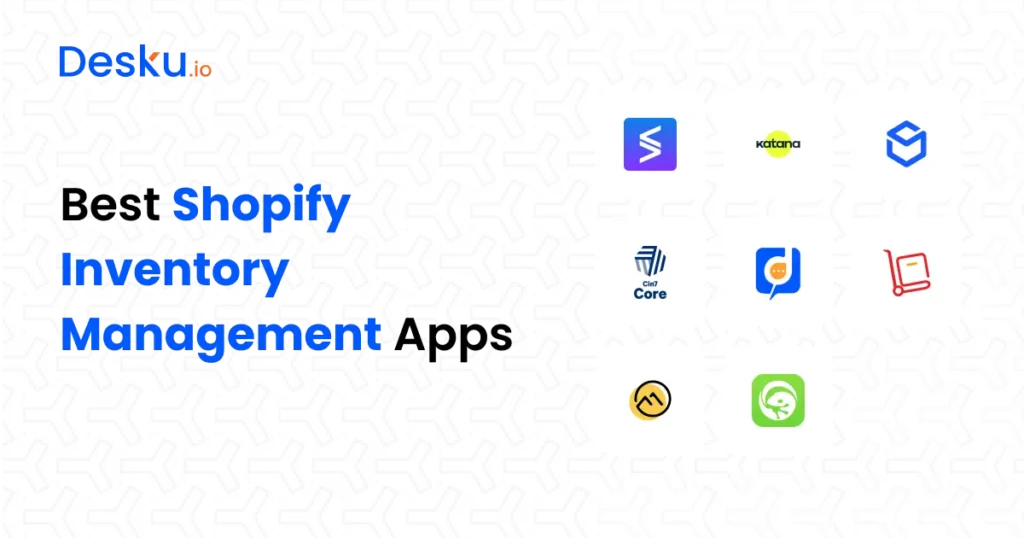Inventory management! Whether you’re a seasoned eCommerce store owner, a fast-growing D2C brand, or a Shopify agency looking to help clients scale, keeping track of inventory can be a daunting task. One wrong move can lead to overselling, stockouts, and ultimately unhappy customers.
But what if I told you that the right inventory management app could solve all these issues? By automating the process and providing real-time updates, these apps help you keep track of your stock levels, manage multi-channel sales, and even forecast demand. In this article, we’ll explore 7 of the best Shopify inventory management apps that can save you time, reduce errors, and help you run your store like a pro.
Shopify Pay Installments is the third most popular payment method globally, used by 14.6% of merchants. (source)
Why You Need a Shopify Inventory Management App
Inventory management can make or break your online store. It’s one of those behind-the-scenes tasks that customers never think about—until something goes wrong. Overselling, stockouts, and manual inventory errors can quickly lead to lost sales and disappointed customers.
Common Inventory Management Issues
- Overselling: Imagine selling a product on your Shopify store, only to find out you’re out of stock. Now you have to either delay the order or cancel it entirely. Neither option is good for customer satisfaction.
- Stockouts: Running out of stock at the wrong time can hurt your business. If a popular item is out of stock, you’re not only losing sales, but you’re also driving potential customers to your competitors.
- Manual Errors: Managing inventory manually is prone to mistakes. Miscounts, misplaced products, and data entry errors can lead to inaccurate stock levels and incorrect orders.
- Lack of Real-Time Data: Without real-time inventory updates, you can’t make informed decisions about restocking, promotions, or managing multiple sales channels.
Benefits of Using an Inventory Management App
- Time-Saving: Automation takes care of updating inventory levels across all your sales channels, freeing up your time to focus on other aspects of your business.
- Accuracy: With real-time tracking, you always know what’s in stock and what’s running low, reducing the risk of overselling or stockouts.
- Multi-Channel Management: Selling on Shopify, Amazon, eBay, and more? The right app can sync inventory across all platforms, so you’re never caught off guard.
- Scalability: As your business grows, so does the complexity of managing your inventory. A good app will scale with your store, making it easier to handle more products and orders without breaking a sweat.
- Automated Restocking: Set up automatic alerts or even trigger orders when stock levels dip below a certain threshold, so you never run out of your best-sellers.
Read More:5 Best Shopify Order Sync Apps
The 7 Best Shopify Inventory Management Apps
Choosing the right inventory management app can make a significant difference in the efficiency and profitability of your Shopify store. Below are 7 top-rated apps, each with detailed features, pros, cons, pricing, user reviews, and overall ratings to help you decide which one best suits your business needs.
1. Stock Sync
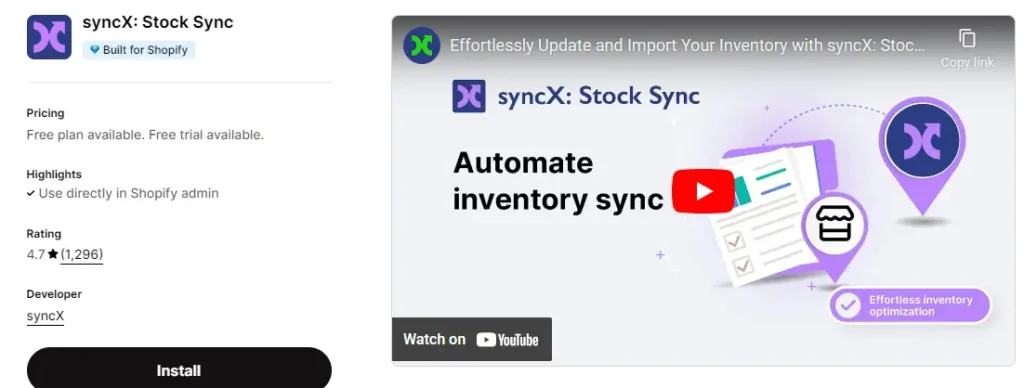
Stock Sync is a user-friendly and cost-effective inventory management app designed specifically for Shopify stores. It is ideal for small to medium-sized businesses looking to simplify their inventory processes without breaking the bank.
Key Features:
- Bulk inventory updates via CSV, FTP, or URL
- Automatic synchronization of inventory across multiple locations
- Multi-supplier support
- Customizable inventory feeds
- Supports over 20 different inventory file formats
- Integration with major dropshipping suppliers
Pros:
- Very affordable, especially for smaller stores
- Easy setup and user-friendly interface
- Excellent customer support with quick response times
- Versatile import/export options for inventory data
Cons:
- Limited advanced features compared to more expensive apps
- Not ideal for businesses with complex inventory needs
Pricing:
- Basic Plan: $5/month (50 SKUs)
- Professional Plan: $10/month (up to 500 SKUs)
- Advanced Plan: $49/month (up to 5,000 SKUs)
- Enterprise Plan: $99/month (custom SKUs)
User Ratings: 4.7/5
User Reviews:
- “Stock Sync is incredibly easy to use and has saved us a lot of time updating our inventory. It’s perfect for our small business.”
- “Great value for money, but if you’re looking for advanced features like forecasting, you might need a more robust app.”
2. Katana
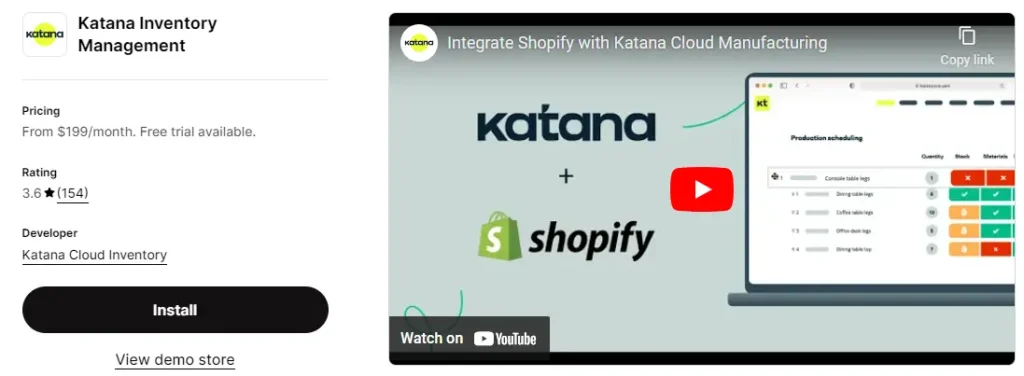
Katana is an inventory and manufacturing management app designed specifically for Shopify stores with production processes. It’s ideal for businesses that manufacture their own products and need a tool to manage raw materials and production.
Key Features:
- Real-time inventory management for raw materials and finished goods
- Production scheduling and tracking
- Multi-channel order management
- Integration with Shopify, Xero, QuickBooks, and other tools
- Visual production planning with drag-and-drop functionality
- Batch and expiry date tracking
Pros:
- Perfect for makers and manufacturers using Shopify
- Visual and intuitive interface makes it easy to manage production
- Seamless integration with Shopify and other tools
- Great customer support and onboarding resources
Cons:
- Not ideal for businesses without a manufacturing component
- Limited advanced inventory features compared to non-manufacturing apps
Pricing:
- Essential Plan: $129/month (up to 500 orders/month)
- Professional Plan: $349/month (up to 2,000 orders/month)
- Enterprise Plan: Custom pricing (for large-scale manufacturing operations)
User Ratings: 4.6/5
User Reviews:
- “Katana is a lifesaver for our small manufacturing business. The production scheduling feature alone is worth the price.”
- “It’s great for managing both raw materials and finished goods, but if you’re not manufacturing, you might find it lacks some advanced inventory features.”
Read More:Top 07 Pre-Order Apps for Shopify
3. ShipBob

ShipBob is a tech-enabled 3PL (Third-Party Logistics) provider that offers inventory management along with fulfillment services. It’s a great option for businesses looking to outsource their warehousing and shipping operations while maintaining control over their inventory.
Key Features:
- Real-time inventory management and tracking
- Multi-warehouse distribution
- Order management and fulfillment automation
- Integration with Shopify, Amazon, eBay, and other platforms
- Analytics and reporting on shipping costs, delivery times, and inventory levels
- Two-day express shipping capabilities
Pros:
- Seamlessly integrates inventory management with fulfillment services
- Real-time data on inventory and shipping costs
- Scales easily with your business as it grows
- Great option for businesses looking to outsource logistics
Cons:
- Limited control over warehousing operations since it’s an outsourced service
- Can be expensive for businesses with low order volumes
- Learning curve for managing the ShipBob platform
Pricing: Custom pricing based on the number of orders, storage space, and additional services required. Typically includes fulfillment fees, storage fees, and shipping costs.
User Ratings: 4.4/5
User Reviews:
- “ShipBob has completely taken the headache out of our fulfillment process. We now have more time to focus on growing our business.”
- “The cost can add up if you’re not moving a lot of volume, but the convenience is hard to beat.”
4. Cin7

Cin7 is a highly customizable inventory management solution that integrates with over 550 platforms. It’s designed for businesses that need robust features for managing inventory, orders, and supply chains.
Key Features:
- Real-time inventory management across multiple sales channels
- Order automation and fulfillment routing
- Multi-warehouse and multi-location support
- Built-in EDI (Electronic Data Interchange) capabilities
- Integration with over 550 platforms including Shopify, Amazon, and Xero
- Advanced reporting and demand forecasting
Pros:
- Highly customizable to fit various business models
- Extensive integration options with third-party platforms
- Strong EDI capabilities for businesses that deal with large retailers
- Scalable solution suitable for growing businesses
Cons:
- Can be expensive, especially with additional integrations
- The platform can be complex, requiring significant setup time
- Customer support can be hit or miss depending on the issue
Pricing: Custom pricing based on the number of users, integrations, and additional features required.
User Ratings: 4.3/5
User Reviews:
- “Cin7 offers everything we need to manage our complex inventory and order processes. It’s a bit pricey, but the level of customization is unmatched.”
- “The initial setup was challenging, but once everything was configured, it’s been a smooth experience.”
Read More:9 Best Shopify Subscription Apps
5. Zoho Inventory
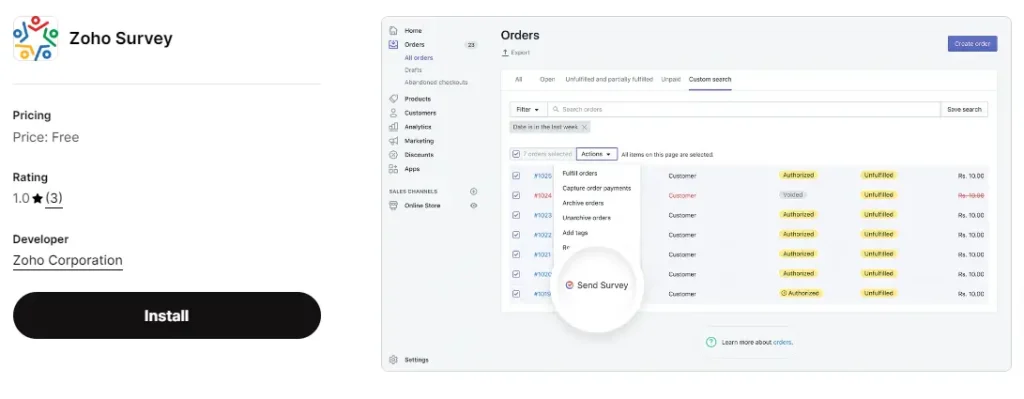
Zoho Inventory is part of the Zoho suite of business tools and offers a cost-effective inventory management solution for small to medium-sized businesses. It’s known for its ease of use and seamless integration with other Zoho products.
Key Features:
- Multi-channel inventory management
- Order and shipping management
- Barcode scanning and batch tracking
- Multi-warehouse management
- Integration with Zoho’s CRM, accounting, and other tools
- Customizable reports and analytics
Pros:
- Affordable pricing, especially for small businesses
- Seamless integration with the Zoho ecosystem
- User-friendly interface with minimal learning curve
- Comprehensive customer support and online resources
Cons:
- Limited advanced features compared to other inventory management solutions
- Not as robust for large businesses with complex needs
- Some integrations outside the Zoho ecosystem can be tricky
Pricing:
- Free Plan: Up to 50 orders/month
- Basic Plan: $39/month (up to 150 orders/month)
- Standard Plan: $79/month (up to 500 orders/month)
- Professional Plan: $199/month (up to 1,500 orders/month)
User Ratings: 4.5/5
User Reviews:
- “Zoho Inventory is perfect for our small business. It integrates perfectly with Zoho CRM and Books, making our operations much more efficient.”
- “It’s easy to use and the customer support is fantastic. However, if you’re a larger business, you might find it lacking in some advanced features.”
6. Orderhive
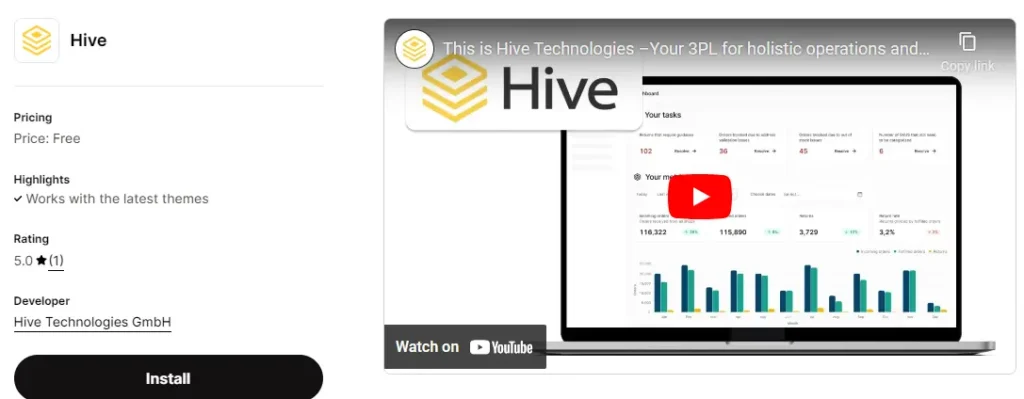
Orderhive is an affordable inventory and order management system designed for small to medium-sized businesses. It offers a wide range of features, including automation, multi-channel management, and integration with various eCommerce platforms.
Key Features:
- Centralized inventory management across multiple channels
- Automated order processing and shipping
- Multi-warehouse management
- Barcode scanning and batch tracking
- Integration with Shopify, Amazon, eBay, and over 100 other platforms
- Customizable workflow automation
Pros:
- Affordable and scalable, with a variety of pricing options
- Strong multi-channel management capabilities
- Easy-to-use interface with powerful automation features
- Excellent customer support with fast response times
Cons:
- Some users report occasional syncing delays with certain platforms
- Limited advanced features for large-scale operations
- Interface can feel a bit cluttered with many features
Pricing:
- Starter Plan: $49.99/month (up to 300 orders/month)
- Professional Plan: $149.99/month (up to 2,000 orders/month)
- Growth Plan: $299.99/month (up to 15,000 orders/month)
User Ratings: 4.4/5
User Reviews:
- “Orderhive has streamlined our inventory and order management across multiple platforms. The automation features are particularly helpful.”
- “Great for small to medium-sized businesses, but might not be the best fit for very large companies.”
Read More:Top 9 Best Shopify Buying Wholesale Apps
7. TradeGecko (Now QuickBooks Commerce)

TradeGecko, now part of QuickBooks Commerce, is a powerful inventory management tool that caters to eCommerce businesses of all sizes. It integrates seamlessly with Shopify and offers comprehensive features for inventory, order, and warehouse management.
Key Features:
- Real-time inventory tracking across multiple sales channels
- Automatic stock level updates
- Multi-warehouse management
- Demand forecasting and purchase orders
- Integration with QuickBooks for accounting and financial management
- Customizable reports and analytics
- B2B eCommerce platform support
Pros:
- Comprehensive feature set that scales with your business
- Excellent integration with QuickBooks, making it ideal for businesses already using QuickBooks for accounting
- Strong multi-channel management capabilities
- Advanced reporting and analytics tools
Cons:
- Higher pricing tier compared to some competitors
- Learning curve for new users due to its extensive features
Pricing:
- Lite Plan: $39/month (up to 500 sales orders)
- Small Business Plan: $119/month (up to 1,500 sales orders)
- Business Plan: $299/month (up to 3,000 sales orders)
- Premium Plan: Custom pricing (for businesses with more complex needs)
User Ratings: 4.5/5
User Reviews:
- “TradeGecko has been a game-changer for our business, especially with its integration with QuickBooks. The multi-warehouse management feature is a lifesaver for our operations.”
- “It’s packed with features, but it took us some time to fully understand how to use them. The support team has been helpful throughout.”
Read More:Top 10 Shopify Outsourced Fulfillment Apps
How to Choose the Right Inventory Management App
With so many great options available, how do you choose the best one for your store? Here’s a quick guide to help you make the right decision:
Evaluate Your Business Needs
- Size of Your Business: Are you managing a small shop or a large-scale operation? The complexity of your inventory needs will help determine which app is the best fit.
- Sales Channels: Consider where you’re selling. If you’re only on Shopify, your needs may differ from a business selling across multiple platforms.
- Budget: How much are you willing to spend? Some apps offer free plans or trials, so you can test them before committing.
Scalability
- Growth Potential: Choose an app that can grow with your business. Even if you’re small now, you’ll want a tool that can handle increased inventory and more complex operations as you expand.
User Reviews and Support
- Read Reviews: See what other users are saying. Are they happy with the app’s performance and customer service?
- Check for Support: Make sure the app offers reliable customer support. Whether it’s 24/7 chat support or detailed documentation, having help when you need it is crucial.
Trial and Error
- Take Advantage of Free Trials: Most apps offer free trials or demo versions. Use these to test out different options and see which one feels right for your business.
Key Features to Look for in Inventory Management Apps
Choosing the right inventory management app can feel overwhelming. With so many options available, it’s important to focus on the features that will truly benefit your business. Here are some of the most critical features to look for:
1. Real-Time Inventory Updates
Real-time inventory updates ensure that your stock levels are accurate across all sales channels. This is crucial for avoiding overselling and ensuring that your customers always know what’s available.
Why It Matters: If you’re selling on multiple platforms (Shopify, Amazon, eBay), real-time updates prevent inventory mismatches. This keeps your customers happy and reduces the likelihood of running into stock issues.
2. Multi-Channel Inventory Management
If your business sells products across multiple platforms, it’s essential to have an app that can manage inventory across all of them. This feature allows you to sync stock levels, manage orders, and update product listings from one central dashboard.
Why It Matters: A multi-channel strategy can boost sales, but it also complicates inventory management. The right app will simplify this by giving you a unified view of your inventory across all platforms.
3. Integration with Other Tools
Your inventory management app should integrate seamlessly with other tools you’re using, such as your accounting software, shipping services, or CRM system. This ensures that all aspects of your business are connected and that data flows smoothly between systems.
Why It Matters: Integration minimizes manual data entry, reduces the risk of errors, and helps streamline your overall operations. The more your apps can talk to each other, the more efficient your workflow will be.
4. Automated Restocking Alerts
Running out of stock on popular items can be disastrous. Automated restocking alerts notify you when stock levels are low, so you can reorder before you run out.
Why It Matters: Staying ahead of stock levels ensures you never miss a sale due to a stockout. Some apps even offer automatic reordering, taking one more task off your plate.
5. Demand Forecasting
Some advanced inventory management apps offer demand forecasting, which uses historical data and trends to predict future inventory needs. This can help you make informed decisions about restocking and scaling your inventory as your business grows.
Why It Matters: Knowing what’s likely to sell in the future allows you to plan more effectively, avoid overstocking or understocking, and optimize your cash flow.
6. User-Friendly Interface
A great inventory management app should be easy to use, even for those who aren’t tech-savvy. Look for apps with intuitive dashboards, clear navigation, and helpful tutorials or customer support.
Why It Matters: The easier the app is to use, the less time you’ll spend learning how to use it and the quicker you can get back to running your business.
7. Customer Support and Documentation
No matter how good an app is, you’re bound to have questions at some point. Reliable customer support and comprehensive documentation (like tutorials and FAQs) are essential for helping you get the most out of your inventory management tool.
Why It Matters: Prompt and helpful support can save you time and frustration, especially if you encounter any issues that disrupt your business operations.
FAQs
What is the best free inventory management app for Shopify?
Several apps offer free plans with limited features, making them ideal for small businesses or those just starting out. [App Name] is one of the top free options, offering basic inventory management for stores with a limited product range.
Do these apps integrate with accounting software?
Integration capabilities vary by app, but many offer seamless connections with popular accounting software like QuickBooks, Xero, and others.
Which app is best for large-scale operations?
For large-scale operations, look for apps that offer advanced features like multi-warehouse support, batch tracking, and robust reporting tools. [App Name] and [App Name] are great choices for businesses with complex inventory needs.
How often do these apps update inventory levels?
Most apps provide real-time updates, ensuring your stock levels are always accurate. This is crucial for avoiding overselling and ensuring customer satisfaction.
Conclusion
Inventory management doesn’t have to be a nightmare. With the right Shopify app, you can automate most of the tedious tasks, reduce errors, and keep your customers happy by always having the products they want in stock. Whether you’re just starting out or managing a large eCommerce operation, one of these 12 apps will be the perfect fit for your needs.
Final Advice: Don’t be afraid to try out a few different apps before making your final decision. Many of these tools offer free trials or demo versions, so you can find the one that works best for your business without any risk.
